
by Sarah Derouin Monday, March 19, 2018
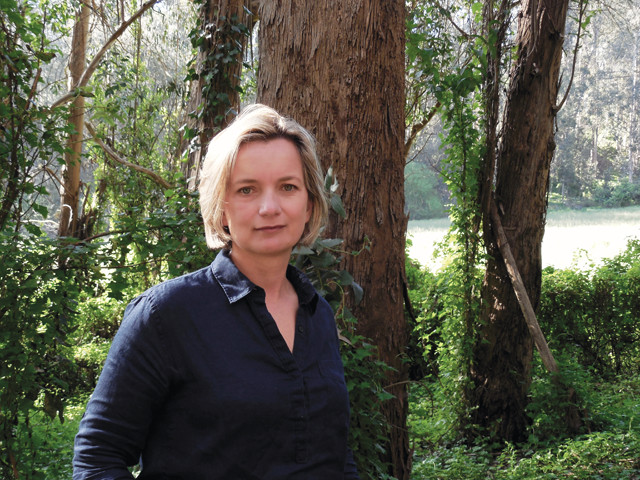
Emily Pidgeon, senior director of the oceans and climate program at Conservation International, led the formation of the Blue Carbon Initiative, an international nonprofit organization that works to mitigate climate change by protecting coastal ecosystems. Credit: Sarah Derouin.
“I can be a very blunt object,” says Emily Pidgeon, describing how she moves through the world and how she approaches her work. Her Australian accent, drawling yet punctuated, rises above the din of the lunch crowd at a café. She pauses a moment, and declares herself a larrikin. “Do you know that word, larrikin?” She explains that Australians have a larrikin culture — they’re troublemakers, but in a good way. “We have a healthy disrespect for authority,” she says, sipping her tea.
Her bluntness may be her most powerful tool. As a scientist, communicator and director of the oceans and climate program at Conservation International, as well as co-chair of the International Blue Carbon Scientific Working Group — which focuses on the environmental fate of “blue carbon” stored in coastal and marine ecosystems — Pidgeon cannot afford to dally. “I work for a nonprofit, which means we don’t have enough time or resources to do what we want,” she says.
Pidgeon and her colleagues work to solve issues related to climate change using two approaches: mitigation, which focuses on reducing the amount of carbon dioxide in the atmosphere, and adaptation, which deals with the impacts of climate change on people and the environment. It’s work that takes her around the world.
“Emily is such a great example of someone who has gone through the classic science training but who then moved outside academia for an alternative position, and she’s been very successful,” says James Fourqurean, a marine ecologist and geochemist at Florida International University in Miami, who frequently collaborates with Pidgeon. There are not enough bright scientists who are working on translating science into policy, he says, but Pidgeon is one of them.
As humans put more carbon into the atmosphere and warm the planet, scientists and policymakers are increasingly interested in how to remove and sequester it. In 2009, Pidgeon authored a summary paper comparing the efficiency of carbon removal in coastal systems versus terrestrial systems, such as forests. The numbers suggested that coastal wetlands can store significantly more carbon than terrestrial systems. “The science had existed for 30 years, but was never presented as a comparison,” she says.
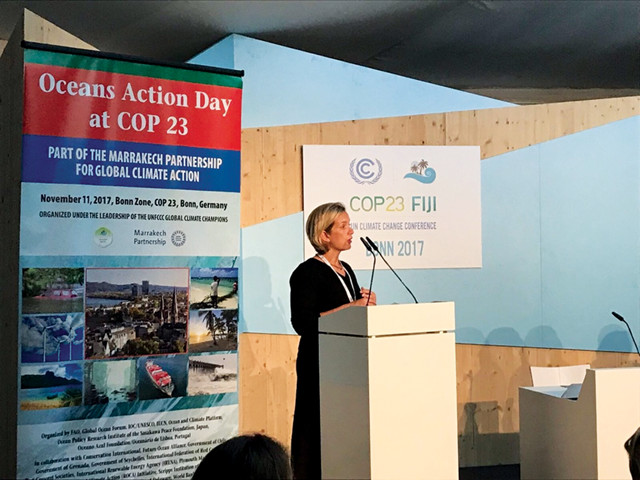
Pidgeon spoke to participants of the November 2017 United Nations Framework Convention on Climate Change in Bonn, Germany, about including wetlands in their commitments to the Paris Agreement. Credit: Jorge Ramos/Conservation International.
Her paper mobilized the scientific community to begin examining blue carbon in more detail. In 2011, Pidgeon led the initial push for the formation of the Blue Carbon Initiative, which works to mitigate climate change by restoring degraded blue carbon coastal environments, like mangroves, sea grasses and salt marshes, while also promoting their sustainable use.
This past year, the scientific working group of the Blue Carbon Initiative focused on developing innovative ways for developing countries to integrate nature-based solutions with traditional engineering — a “green-gray” approach — while allowing each country to manage their coastal wetlands by concentrating their effort and resources on specific conservation projects.
It’s easy to see where Pidgeon’s love of coastal environments comes from; Pidgeon grew up in Perth, Australia, which she reverently refers to as “the edge of the universe.” She describes an idyllic childhood — the beach down the street from her parents’ house, no tourists crowding the town, no crime. “Growing up in Perth ruins you” for living elsewhere, she says.
With an aptitude for math and physics, she studied engineering at the University of Western Australia in Perth, where she recalls watching movies created by MIT professors. “Very dry, very 1950s, with men in black suits and amazing glasses,” she says. But the videos showed the beautiful symmetry of math and fluid mechanics, which she found captivating.
Encouraged by her undergraduate mentor to attend graduate school, and desperate to see the world, she applied to universities in the U.S., and was accepted by Stanford, MIT and Caltech. Ultimately, she chose Stanford, mostly because she had already worked with one of her future professors while he was on sabbatical at the University of Western Australia.
After completing her doctorate in 2000, Pidgeon took a postdoctoral position at Scripps Institution of Oceanography researching the fluid dynamics of tides within the layers of the ocean. After a postdoctoral stint, someone on Pidgeon’s career path might typically apply for an academic job, but her heart wasn’t in it. “I knew I wanted something else,” she says. “I needed a big picture.”
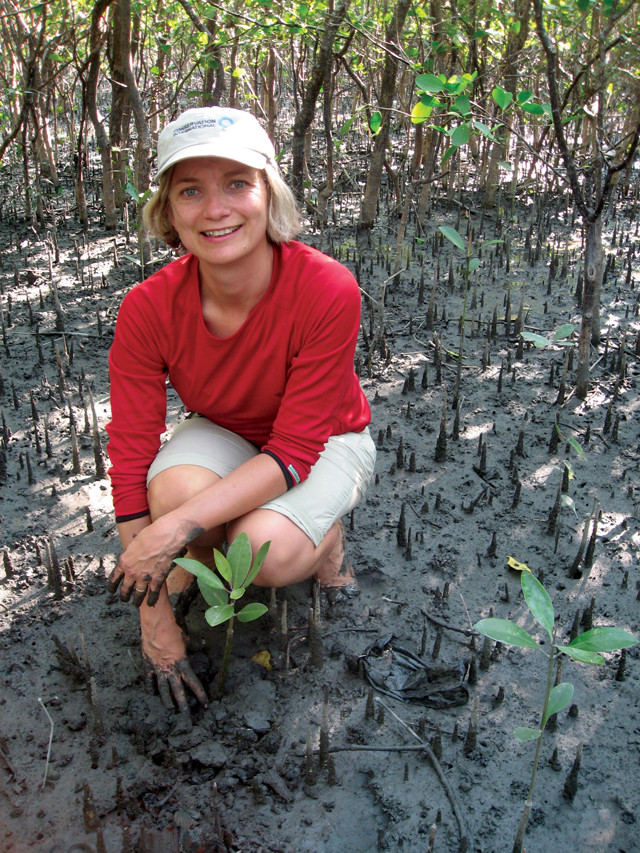
Pidgeon plants mangroves in the Verde Island Passage region of the Philippines. Credit: Enrique Nunex/Conservation International.
That something else turned out to be a position at Conservation International — an environmental nonprofit that focuses on nature-based solutions for the world’s most vulnerable people — where she helped create and implement a marine climate change program. The program partners with scientists, industry, government and local communities on climate projects in Brazil, Costa Rica, Ecuador, Indonesia, Madagascar and the Philippines. Pidgeon has worked with Conservation International since 2006, first as the director of marine climate change, and now as senior director of the oceans and climate program.
Preserving blue carbon environments such as mangroves and salt marshes has rippling benefits to coastal communities, Pidgeon says. In coastal environments, carbon is trapped and stored either in plants and, even more effectively, in the soil that supports them. Carbon-rich soils in blue carbon wetlands can be meters thick and can lock up carbon for millennia — if, that is, the coastal ecosystem stays in place, undisturbed. But these environments are under stress and being degraded, which weakens their ability to sequester carbon. Over the last 50 years, up to half of the total area of mangrove forests has been lost globally, and they continue to disappear at a rate of up to 2 percent a year, according to a 2011 Nature Geoscience study.
Beyond carbon storage, coastal wetlands provide protection from tropical storms and hurricanes. Wetlands buffer powerful winds and waves, and the loss of these ecosystems can exacerbate coastal storm damage and its economic impacts on industries like tourism and fishing. In the Philippines, for example, about 70 percent of mangroves have been removed within the central islands to make way for shrimp farms, Pidgeon says. These areas have since suffered the most damage from typhoons, including Super-Typhoon Haiyan in 2013, during which coastal communities experienced storm surges of up to 6 meters.
Pidgeon’s group talks to communities and governments about the importance of restoring mangroves to help protect themselves from storms like Haiyan. “There’s a need for combining these natural solutions with enough traditional engineering to get people the protection they need,” Pidgeon says. She has been working with engineers to help shape green-gray approaches, such as combining mangrove restoration with constructed breakwaters.
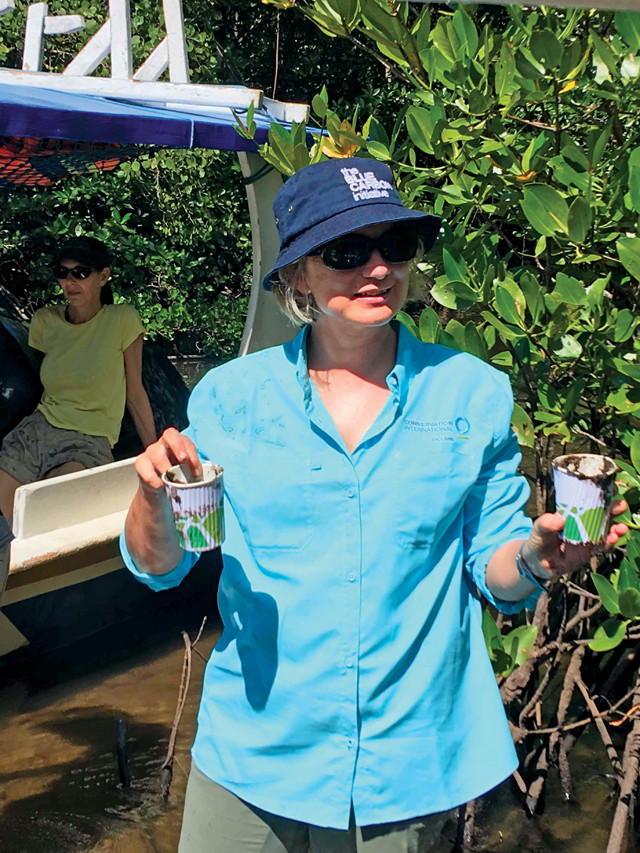
In the field in Bali, Indonesia, Pidgeon talks about mangrove ecosystems, conservation and restoration. Credit: Conservation International.
Pidgeon and her colleagues at the Blue Carbon Initiative also work with governments to implement policy decisions related to restoration funding, conservation legislation, and achieving carbon storage goals made as part of pledges like the 2016 Paris Agreement.
To raise awareness of blue carbon-related solutions as a means of climate change mitigation, Pidgeon spoke at the 2017 United Nations Framework Convention on Climate Change. “These blue carbon solutions are important because if you are a country with a lot of mangroves, sea grasses or salt marshes, you should get credit for that toward your carbon goals,” she says.
Adding blue carbon to the global carbon market can also make room for cap and trade options, Pidgeon says. “In some places, if you’re a company, there’s a cap on how much carbon you can emit,” she explains. “If you emit more than that, you have to offset it by buying from the carbon market.” Including blue carbon projects in the market can allow communities to sell their credits to other countries or companies, creating revenue.
Some roadblocks on this path, however, stem from how governments are set up, she says. “In many places I visit, climate change and oceans are managed by different ministries.” People tell her the work isn’t possible because there are two ministries and coordination is nonexistent. “I get annoyed at such problems and want to solve them,” she says. She moves past her exasperation. “Integrating across disciplines … It’s just fun,” she says, lightheartedly.
Pidgeon breaks down a scenario common in her work. “You would talk to the policymakers and they would say, ‘We have no data [with which] to analyze carbon in coastal wetlands.’ And then you go to the scientists and they say, ‘That’s not true, look at all the data we have.’ But the problem is, the data the scientists have is not the data the policymakers need.” That’s where Pidgeon puts her skills as a communicator and scientist to work, translating and relaying the policymakers’ needs to the scientists. And the scientists have been receptive, she says — they want their work to be valuable and useful. “Now there’s a whole troupe of doctoral students out there knee-deep in wetlands doing completely different measurements because we managed to have this conversation.”
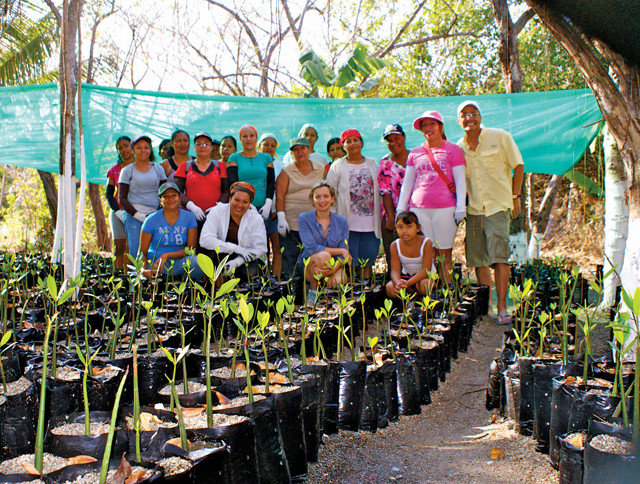
On Chira Island in Costa Rica, a women's group that is restoring mangroves to protect the island against the impacts of climate change poses with Pidgeon behind a cluster of mangrove seedlings. Credit: Marco Quesada/Conservation International.
Pidgeon says she wants to help other scholars open up their own lines of communication. She’s working with scientists at Scripps on how to increase their research impact. “They want to see their science used, and they want to have their science supported broadly, but they don’t know where to get started,” she says.
Jennifer Howard, the marine climate change director at Conservation International, says Pidgeon is an expert at bridging science and policy: “Emily spent the last five to six years getting the science right, working on the methods.” According to Howard, Pidgeon has moved decision-makers from “Is restoration possible?” to “How do we do it?” Although blue carbon is Pidgeon’s expertise, if it’s not the best conservation option, she won’t insist on it. “It’s been great for me to watch,” Howard says. “It helps colleagues listen because she’s not pushing her own program.”
Pidgeon says she likes to make sure each conversation is important and appropriate for the audience. For example, she says when she talks to the Indonesian government, she discusses bigger-picture issues like carbon emissions, but when she talks to a village, she focuses on fishing and conservation.
“I am like a conductor between science and conservation,” Pidgeon says. An underutilized tool in merging science and policy, she says, is having scientists, policymakers and community members involved early on, which “builds a sense of trust between the groups,” she says. One way to achieve that is getting people to relax around a table. “I find beer is a really useful tool,” Pidgeon adds with a laugh, admitting she’s being a bit flippant. In her larrikin way, Pidgeon wants to help communities understand how special their blue carbon ecosystems can be, on both local and large scales, while also changing the global conversation about addressing climate change.
© 2008-2021. All rights reserved. Any copying, redistribution or retransmission of any of the contents of this service without the expressed written permission of the American Geosciences Institute is expressly prohibited. Click here for all copyright requests.